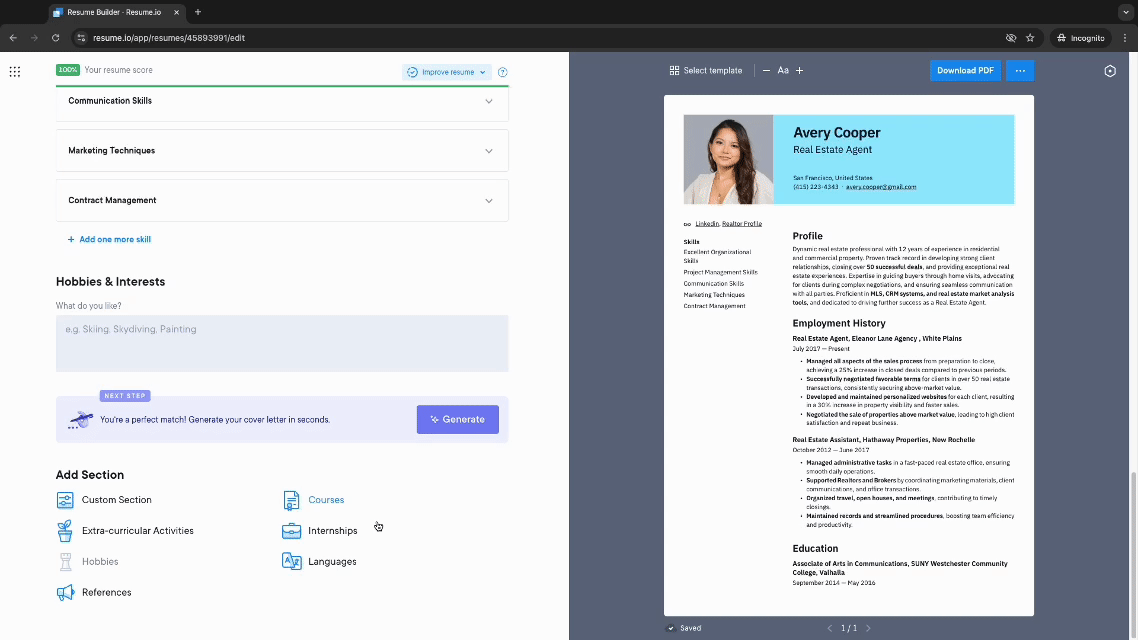Do you know how to say “resume” in another language? Being bilingual can be a major advantage in today’s job market—if you know how to highlight these skills on your resume.
In this guide, we’ll show you how to write a bilingual resume that makes hiring managers take notice of your language skills.
Where to put bilingual skills on a resume
Bilingual skills can fit in more than one place on your resume, depending on the job and your proficiency level.
Here are four common sections where you can showcase language skills on your resume:
1. In a resume summary
If bilingual skills are essential for the role, mention the languages you speak in your resume summary. Highlighting your language skills here can quickly show hiring managers your value.
Put bilingual skills in your resume summary if:
- The job posting mentions a specific language requirement.
- Your language skills can set you apart from other candidates.
- You’re applying to work for a global company with locations where you speak the local language.
Bilingual marketing specialist fluent in English and Korean with four years of experience creating campaigns for Asia-Pacific audiences. Passionate about cross-cultural branding and customer engagement.
2. In a work experience section
Include your bilingual skills in your work experience section to show how you’ve used them on the job. For example, you can write bullet points describing how your language skills have helped you translate materials or interact with international clients.
Mention your language skills in your work experience section if:
- You’ve used these skills regularly in your past positions.
- You want to show an employer how you can use these skills in a new role.
- You have tangible proof, such as data or examples, that your language skills have added value in other roles.
Customer Service Representative
Transatlantic Call Center | January 2022–Present
- Provide bilingual customer support in English and French, contributing to a 92% customer satisfaction rate.
- Translate documents from French to English to support customer service teams across three international offices.
3. In a skills section
For some jobs, speaking a second language may be helpful, even if it’s not a requirement. In this case, include the languages you speak in your skills section, along with your proficiency level.
List bilingual languages in your resume skills section if:
- Language skills may come in handy for the role.
- You want to describe your proficiency level in each language you speak.
- You’re applying for jobs where knowing another language might give you an edge over other applicants.
- Data analysis
- Microsoft Office
- Customer service
- Customer relationship management software
- Bilingual: English (Native) and Vietnamese (Fluent)
4. In a languages section
If you want to really shine a spotlight on the languages you speak, create an additional section for them. Label this section “Languages” and list each one you know.
Use a dedicated languages section if:
- You speak three or more languages and want to list each of them.
- You want to include additional information, such as formal language training or certifications you’ve earned.
- You’re applying for international jobs where bilingual skills are essential.
- English (Native)
- Spanish (Advanced, DELE C1)
- Mandarin (Intermediate)
How to put bilingual skills on a resume
Now that you know where to put them, here are four tips on how to list bilingual skills on a resume:
1. Review the job description
When writing a bilingual resume, start by reading the job description closely. Does the employer require or prefer candidates to have bilingual skills? If so, plan to feature these skills prominently on your resume, such as in the summary or a separate languages section.
2. Highlight your language achievements
Make your bilingual skills stand out by showing how you’ve used them to achieve success. For example, if you’ve used a second language to close deals or expand market reach, highlight those accomplishments on your resume. Framing your achievements like this can show an employer how your language skills can benefit their team or organization.
3. Mention your proficiency

Instead of just saying you are bilingual, include more details about how well you speak another language. Listing your proficiency level can provide more context about the bilingual skills you can bring to the new role.
Standard proficiency levels include:
- Native. Your native language is the one you grew up speaking.
- Advanced. While not your native language, an advanced-level proficiency shows that you can speak the language fluently.
- Intermediate. If you’re an intermediate speaker, you can hold moderate conversations with others, but don’t have the same proficiency as a native or advanced speaker.
- Basic. A basic proficiency indicates that you can speak some words and phrases, but you probably can’t have lengthy conversations with others.
4. Don’t oversell your skills
Remember, if you say that you can speak another language on your resume, an employer may ask you to prove it. Avoid calling yourself “advanced” or “fluent” unless you can easily speak, read, and write the language. It’s better to be honest than to get stuck in an awkward situation where you can’t communicate with a person who actually speaks the language.
Once you’ve identified how and where to present your language skills, the next step is formatting them clearly and professionally. An AI Resume Builder can help you do this quickly by offering customizable templates and smart suggestions based on your experience and language proficiency.
Bilingual skills on a resume examples
Check out these examples of how and where to put bilingual skills on a resume:
Translator resume
Applying for jobs where you need to speak different languages? This example shows how to describe bilingual skills in multiple places on your resume:
Call center agent resume
If you’re applying for jobs where bilingual skills aren’t required but might be nice to have, this resume example shows you how to highlight them in your skills section:
Need more inspiration? You can find more of these helpful resume examples and market-tested templates in our resume.io online resume builder.
FAQs about bilingual resumes
Here are some other frequently asked questions about writing a bilingual resume:
How do you say you are bilingual on a resume?
You can say you’re bilingual by listing the languages you speak in a skills or language section, or working it into your resume summary. You can also add bullet points about utilizing your bilingual skills in your resume work experience section.
How can you describe bilingual skills on a resume?
Describe your bilingual skills by including your proficiency level (such as native, advanced, or intermediate). You can also provide additional context, such as how you’ve used your language skills to negotiate international deals or communicate with customers in other languages.
How do you say you are bilingual in a cover letter?
In your cover letter, provide relevant examples that show how you’ve used your bilingual skills successfully in other jobs. For example, you can write about how you’ve used your language abilities to bridge communication gaps between team members in different countries.





